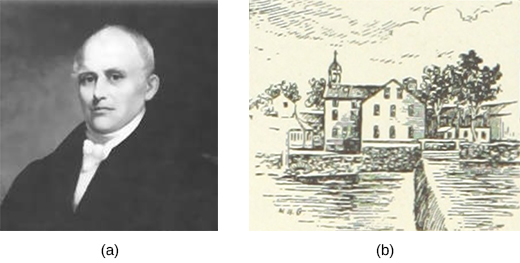| << Chapter < Page | Chapter >> Page > |
Much of this part-time production was done under contract to merchants. Some farming families engaged in shoemaking (or shoe assemblage), as noted above. Many made brooms, plaited hats from straw or palm leaves (which merchants imported from Cuba and the West Indies), crafted furniture, made pottery, or wove baskets. Some, especially those who lived in Connecticut, made parts for clocks. The most common part-time occupation, however, was the manufacture of textiles. Farm women spun woolen thread and wove fabric. They also wove blankets, made rugs, and knit stockings. All this manufacturing took place on the farm, giving farmers and their wives control over the timing and pace of their labor. Their domestic productivity increased the quantity of goods available for sale in country towns and nearby cities.
In the late 1790s and early 1800s, Great Britain boasted the most advanced textile mills and machines in the world, and the United States continued to rely on Great Britain for finished goods. Great Britain hoped to maintain its economic advantage over its former colonies in North America. So, in an effort to prevent the knowledge of advanced manufacturing from leaving the Empire, the British banned the emigration of mechanics, skilled workers who knew how to build and repair the latest textile machines.
Some skilled British mechanics, including Samuel Slater, managed to travel to the United States in the hopes of profiting from their knowledge and experience with advanced textile manufacturing. Slater ( [link] ) understood the workings of the latest water-powered textile mills, which British industrialist Richard Arkwright had pioneered. In the 1790s in Pawtucket, Rhode Island, Slater convinced several American merchants, including the wealthy Providence industrialist Moses Brown, to finance and build a water-powered cotton mill based on the British models. Slater’s knowledge of both technology and mill organization made him the founder of the first truly successful cotton mill in the United States.

The success of Slater and his partners Smith Brown and William Almy, relatives of Moses Brown, inspired others to build additional mills in Rhode Island and Massachusetts. By 1807, thirteen more mills had been established. President Jefferson’s embargo on British manufactured goods from late 1807 to early 1809 (discussed in a previous chapter) spurred more New England merchants to invest in industrial enterprises. By 1812, seventy-eight new textile mills had been built in rural New England towns. More than half turned out woolen goods, while the rest produced cotton cloth.
Slater’s mills and those built in imitation of his were fairly small, employing only seventy people on average. Workers were organized the way that they had been in English factories, in family units. Under the “ Rhode Island system ,” families were hired. The father was placed in charge of the family unit, and he directed the labor of his wife and children. Instead of being paid in cash, the father was given “credit” equal to the extent of his family’s labor that could be redeemed in the form of rent (of company-owned housing) or goods from the company-owned store.

Notification Switch
Would you like to follow the 'U.s. history' conversation and receive update notifications?